‘An alchemist of color, Micheau-Vernez has worked through all its mysteries’
| Micheau-Vernez is not a Breton painter in his choice of subjects, but a Breton who devoted his life to painting. He found his vocation at an early age and, with the support of excellent teachers and thanks to his undeniable gift, he developed his own vision. A witness of his time, he offered up his own nugget of truth, his optimistic and highly-colored version of our world. |
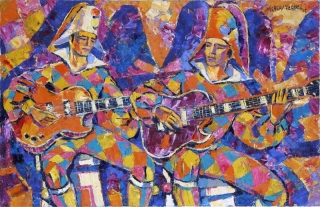
The Harlequins, oil, 1977, 65 x 100 cm
|
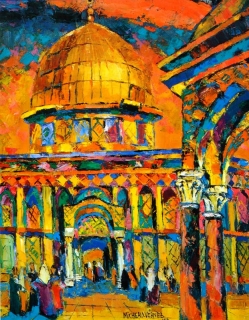
The Omar Mosque in Jerusalem
Oils, 1977 – 92 x 73 cm
|
His productive period coincided with a period in our time when painting and contemporary art were going through a profound mutation. Feeling a need to break free of the past, a part of the world of art turned to provocation, choosing to disregard both technique and aesthetics. Micheau-Vernez did not change his outlook, though it meant going against the flow of fashion. Determined to progress ever further on the path he had chosen, and confident that this path was not fully explored, this demanding artist destroyed his work whenever it did not satisfy him fully. This was the nature of his quest. A technician in paints, in the scientific meaning of the word, he dissected the great Masters’ inventions. A perpetual seeker in aesthetics, he reached after long consideration for new, apparently antinomic blends of color, and attained a mastery comparable to that of a conductor leading his musicians. |
He admired Gauguin, Cezanne and Bonnard: three pillars of painting, different but complemental. He felt their work was not a completion, but an opening. Micheau-Vernez did not try to please but trusted to his vision of art.
| Painting is first and foremost the art of color
Painter LĂ©on Degant came with Micheau-Vernez’s friend Charles Estienne (a professor of history in Brest and a famous art critic) to visit him in Grasse in April 1948. Estienne, fascinated by Kandinsky’s work and his quest for lyrical abstraction, offered to introduce Micheau-Vernez into a small coterie recently joined by Jean Deyrolle. The painter refused, as he felt this would be in contradiction with his artistic ethos. Years later, in 1968, he met Alberto Magnelli several times, and the Italian painter argued against his reluctance to put himself forward – in vain. |
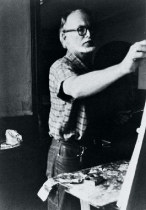
Quimper 1960
|
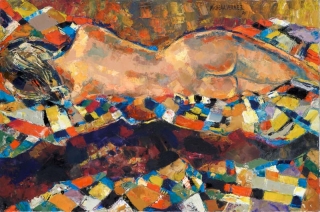
Nude lying down, from the back – oil, 1970 – 54 x 81 cm
|
Micheau-Vernez did not believe in the technique of pure abstraction. For him, to start from nothing was to negate the intelligence, the whole fabulous sum of knowledge contained in the history of art. He agreed with Picasso that : “an abstract canvas is only a catch-all where anyone can find what he likes”. He did however make a distinction with art, which is an abstraction in itself. |
| « Each touch of the brush catches the light … »
In 1978, following the exhibition in the Galerie Drouant, art critic AndrĂ© Parinaud wrote: “what we are seeing is a man’s lifework surging into the light after a fifty-year-long tunnel of silence – and yet this work was created in a solar light, and doubtless in celebration of life’s profound sensuality. Micheau-Vernez is a dream, who could doubt it! But who will express the powerful rage hidden in the philosopher’s heart ? His painting proclaims his strength and self-confidence; it is both structured and fiery. Each sure-handed touch of the brush catches the light with a magnificent technical precision. Yet this skill would be a small thing without that lover’s eye, full of appetite, attention, depth, which masters the painter’s intentions. These are nuggets of sunlight set by a master, like gems in a relic, and offered up with a workmanlike discretion; the tones and the supreme elegance cease to be noticed when they become a style.” |
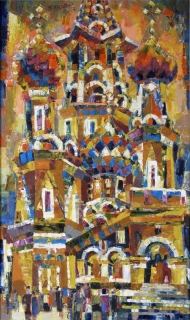
Russian Church – 1968
oil, 146 x 89 cm
|
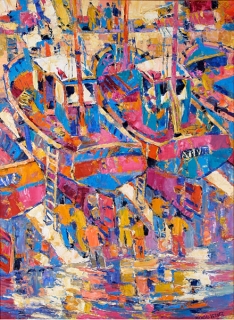
oil, 1982 – 130 x 97 cm
|
During the same period, Jacques Dubois, art critic for the L’Amateur d’art magazine, also wrote: “an alchemist of color, Micheau-Vernez has worked through all its mysteries. As a painter of shapes, he reconstructs their terms with a sureness born of maturity. Using overlapping spots of pure color laid on with a palette knife, his highly personal style indicates a strong temperament, in which movement is launched by a musical gesture, taking us into a sun-drenched world. A confirmed talent, a deep soul, a science built up from research and experiment.” |
| The word that comes to mind is: an authentic painter. Micheau-Vernez was a man of faith, gifted with an optimism which almost amounted to innocence. His spirit remained youthful, even when he painted his last picture at 81. “Music and painting are closely related” he used to say. “Beethoven’s construction and color scheme were those of a great painter, just as Gauguin and Cezanne were great composers. In the same way, my painting is like music, each score an abstraction in itself but composed as a part of a significant whole.” |
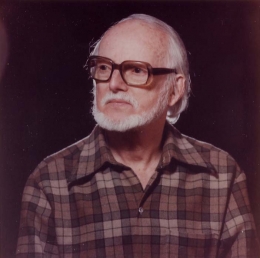
Micheau-Vernez in the seventies
|








